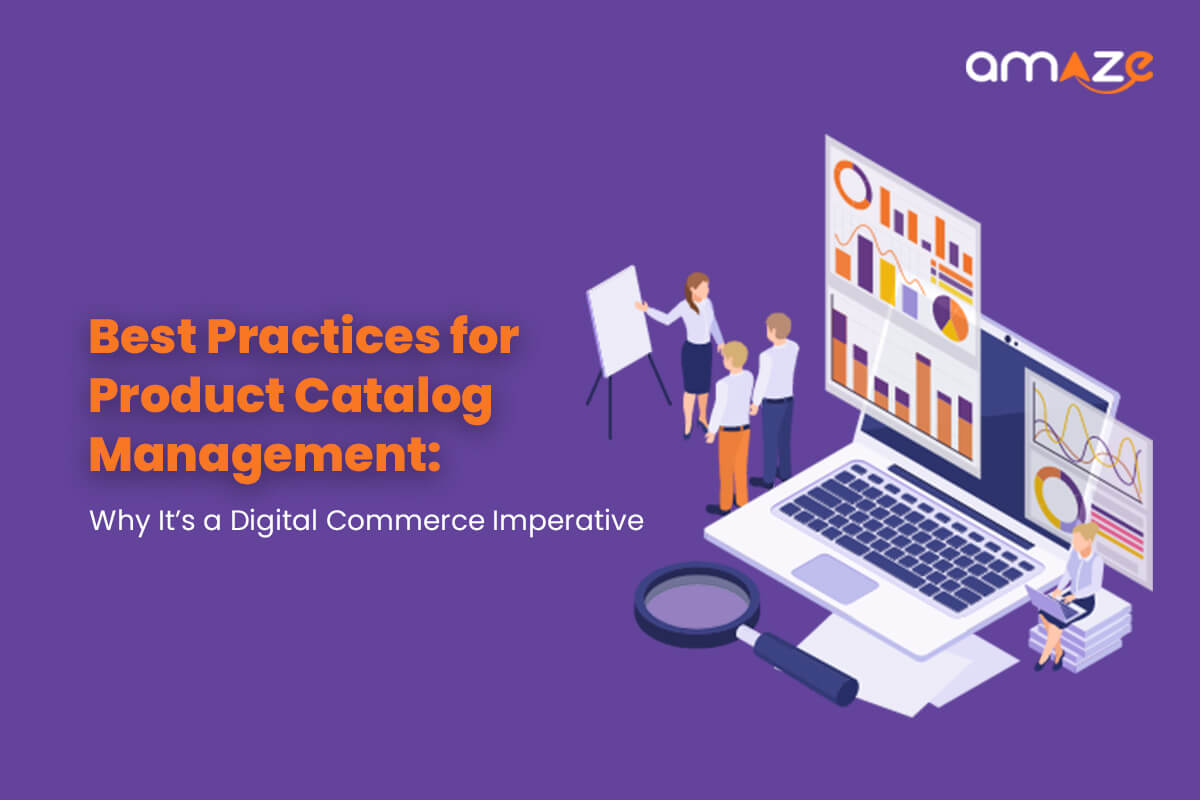Best Practices for Product Catalog Management: Why It’s a Digital Commerce Imperative

The market for product catalog management systems is expected to grow from USD 1.2 billion in 2020 to USD 1.9 billion in 2026 (Source: Markets And Markets). Share this as a Tweet
Key factors that will fuel this growth are growing internet access, rising smartphone penetration, and rising consumer demands. Consumer demand and changing buying behavior combined with increased adoption of cloud and digital transformation strategies by companies will further drive the surge in the demand for product catalog management systems to integrate the product data management process across the ecosystem that includes manufacturers, retailers and distributors.
What is Product Catalog Management?
Product catalog management ensures that product data is organized, up-to-date and structured across sales channels, and in keeping with larger business objectives. Sounds like the most basic thing to do, yet, it is a rudiment that so many modern-day businesses overlook.
Picture this: You’re on an online marketplace looking for a shoe rack. You find one that looks about right, but you want to know how big it is, what color it is available in, whether it comes assembled or requires assembly etc. The product dimensions seem to be in different units of measurement; some are in meters; others are in feet. The color reads “red” in the description, but “maroon” in the list of attributes. Again, the description says nothing about assembly.
Do we need to say more? The above is an example of not just incomplete, insufficient or misleading information, it is the perfect recipe for a poor customer experience and lost trust. Now think of the same example in a B2B scenario where the relevance of attributes only increases in criticality.
Acing Product Catalogs – Product Catalog Management Best Practices
Given that your product catalog is the core of your merchandising strategy, it is imperative to get it right. And doing so is not a matter of fluke, neither does it have to be a dedicated, repetitive manual effort that could be prone to errors. Here are some effective best practices to master the art and science of product catalog management:
1. Work on Product Data Integrity, Completeness and Timeliness
Your primary goal when working on a product catalog should be to earn your customer’s trust.
Product data helps customers connect the dots in the buying journey. Share this as a Tweet
And this can only be achieved when your product data is complete, consistent and up-to-date. When we say “complete”, we don’t mean “just about enough”. The product information provided on the catalog must not only describe the product, it should also elaborate on how the product will add value to the customer’s experience. This could include visuals, videos, use cases, and other digital assets.
That said, it’s not just about adding the bells and whistles. Your data must also be up-to-date for it to have any relevance. For example, if your inventory has been updated, but this doesn’t reflect in the catalog, there’s a good chance that customers get something very different from what they originally purchased. This could and will throw a spanner in the works when looking to earn customer trust.
2. Use Taxonomy & Attribution to make your Products Easy to Find
Product taxonomy defines how you categorize your products – a factor that is super critical when it comes to product findability. However, many organizations go a bit myopic at this stage, categorizing products based on a few technical or business related structures that don’t really matter to the customer. The key here is to build taxonomy and categorize products intuitively, making life easier for the customer. Then again, categorization can play a major role in driving SEO, so it’s imperative to have taxonomy looked at from all these different angles. A good starting point to achieve this could be competitor analysis. However, nothing beats a strong, thorough understanding of your range of products and services and an equally good sense of what your customers want and how they shop for it.
Along similar lines, you have attribution, commonly known as tagging, that lets customers refine, filter and sort products based on their preferences. While attributes must be normalized within categories (don’t use “M” for one product and “Medium” for the other), they can’t be standardized across product types. For example, while “dimensions” are relevant for a chopping board, you wouldn’t want the same attribute for a pack of crisps.
3. Leverage Product Data for Multichannel/Omnichannel Selling
Marketers that use over three channels in a campaign earn a 494% higher order rate than those using a single channel campaign – Omnisend. Share this as a Tweet
Modern-day customers almost never use just a single channel in the purchase journey. Some may choose mobile, others may shop on their desktop; some may also research online and buy in-store. For this reason, it is imperative to have product data designed to cater to all these channels, and the innate differences that exist therein. For example, while a detailed product description might be useful for selling on a marketplace, the same might not work on social media. Then again, an Amazon might have a very different set of standard requirements from a Grainger.
Successful product catalog management considers all these variations to create a set of product data that’s not just complete, but also holistic from the multichannel point of view.
4. Upsell & Cross-Sell Products
Getting customers to land on a product is a big deal. It opens the door to a prospective sale. But the opportunity doesn’t end here. Your customer’s attention is everything, so it’s important to make the most of it while you have it. And this is where cross-selling and upselling come into the mix.
Cross-selling involves the proposal of a product related to the original product the customer is looking for. For example, a customer is looking to purchase a phone, and you suggest phone covers, selfie sticks or other related products. This gives you the opportunity to increase the average order value, and it is also a great way to give customers something to look at even if they’ve hit a dead-end with a “no result” page. While the latter is not ideal, it’s still a better way to make the best of a bad situation.
Upselling products involves getting your customers to take note of products that are a better/bigger version of what they’re looking at. For example, if they’re on the page for medium fries, you could suggest large fries at a better price.
5. Define Processes & Roles to Better Manage Your Catalog
Given that multiple stakeholders have an active role to play in product catalogs, businesses must map processes and stakeholders for clarity. This makes it easier to identify internal and external stakeholders at crunch moments. It provides visibility of which stakeholders impact which part of the process and who these changes impact.
And this brings us to the larger challenge of maintaining a larger source of truth. The product catalog management system you choose should be a single source of truth for the product catalog/catalogs. Any change made to product data at any specific stage should reflect on this centralized repository with the required flags and notifications. Again, you must also have the ability to authorize access and control to ensure better management of product data at any given touchpoint.
6. Leverage Analytics, AI & Personalization
Analytics can be used to gain useful insights on everything from catalog health to data integrity. It gives a clear and objective view of aspects such as catalog completeness and product data completeness to raise flags where required, and gain a bird’s-eye-view of catalog health. Similarly, analytics can also be used to predict trends and buying behaviors to design catalogs that are more effective and relevant.
Similarly, artificial intelligence, or AI, can be used to accelerate the process of analytics. Furthermore, it can be used to carry out tasks such as smart, automated product data onboarding, enrichment and distribution. AI-powered taxonomy templates and suggestions can be used to accelerate the process of structuring and populating catalogs faster than any manual process. Accelerated time-to-market, increased accuracy and ongoing learning and improvement are only a few of the many benefits businesses can expect by implementing AI-powered solutions for catalog management.
“Your customer doesn’t care how much you know until they know how much you care” – Damon Richards. Share this as a Tweet
Just like you would like to tailor product information for different sales channels, it is important to do the same for different customer types as well. The combined forces of AI and analytics can go a step further, by predicting customer behavior, preferences and expectations, and fulfilling them with personalized buying journeys. For example, you can sequence products differently based on customer preference data, or leverage differentiated pricing depending on the ordering situation and value.
Power Product Catalog Management with a Next-Gen PIM
Finding the right system for product catalog management enables your business to deliver an unforgettable customer experience. But it also requires the right mix of experience and expertise to help you set the right foundation for digital commerce growth. And this is exactly what you get with Amaze PXM
- A Next-Gen PIM:A one-stop shop for your product catalog needs, Amaze PXM is a truly next-gen solution that gives you end-to-end control of the data journey. It combines syndication, PIM and DAM capabilities to make you the true master of your product catalog!
- 360-degree Data Excellence:Amaze PXM lets you create and optimize your catalog from the ground up. It fuels the data journey with automated syndication and gives you the required levers to optimize browse and search functions.
- Multiple Catalog Building:Create multiple catalogs manually, or import templates for accelerated catalog building. Leverage data standardization rules for uniformity across catalogs.
- AI/ML for Accelerated Catalog Building:Amaze PXM gives businesses the power to accelerate the journey of product catalog creation with smart recommendations for taxonomy building, and machine learning capabilities that ensure constant learning and improvement.
- Data Governance & Stewardship:With functions such as validation management, Amaze PXM gives businesses complete control over data quality and integrity. Advanced security measures ensure impenetrable authorization and authentication mechanisms.
- The Human Touch:With over two decades of experience, Team Amaze has the required expertise to help you strategize and build product catalogs that drive business objectives. With ongoing support and guidance, you can be rest assured that the Amaze magic never stops.
Curious to learn more about how Amaze PXM can drive your digital journey with next-gen product catalog management?
Related Articles
Recent Post
Categories





